
Planet Quest
Cat: SCI
Pub: 1997
#: 0221b
Ken Croswell
02531u/18130r
Title
Planet Quest
惑星探索
Sub
Title
The Epic Discovery of Alien Solar Systems
他の太陽系発見の叙事詩
Author
Ken Croswell
ケン・クロスウェル
Published
1997
1997年
Index
Just
400
years
ago
>Top Feb 17 1600:
- It was Thursday morning, February 17,
1600, and the crowd in Rome was jeering. A 51 year old former priest,
condemned as a heretic by the Inquisition, was being led, in chains,
to his death. Giordano Bruno was born in 1548, just 5 years
after Copernicus published his revolutionary claim that the Sun
constituted the center of the Universe.
- Bruno, though, gladly adopted Copernicus's
heliocentric model and took it even further. Copernicus thought
the stars were merely part of the firmament, but Bruno proclaimed
that they were actually distant suns scattered throughout a universe
infinite in size. Around these suns circles planets. Bruno also
predicted that additional planets, too distant to be seen, revolved
around the Sun beyond the orbit of Saturn, the farthest planet then
known.
1600年2月17日
- 木曜日の朝に、ローマの群衆は嘲笑していた。51歳の元司祭は、ついに宗教裁判所で異端と断罪され、鎖につながれて処刑された。ジョルダーノ・ブルーノは1548年に生まれた。その誕生の年はコペルニクスが太陽が宇宙の中心であるという革命的な主張を発表してから5年後のことであった。
- ブルーノはコペルニクスの地動説を喜んで受け入れただけに留まらなかった。コペルニクスは星々は単なる天空の一部と考えたが、ブルーノはそれらは無限の宇宙に広がる遠方の太陽であると主張した。これらの太陽たちの周りには惑星が回っている、と。ブルーノはまた当時は最も遠方の惑星であった土星の軌道のさらに外側に、それはあまりに遠方で見えないが別の惑星が存在することを予測していた。
English
Japanese
>Top 1. A Good Planet Is Hard To Find:
- Stars and galaxies litter the sky in vast quantities, but until
1991 known planets numbered a mere nine. The discovery of other
planets would help reveal the rules that govern planetary systems
and allow astronomers to see whether our own solar system is typical
or instead highly unusual - two possibilities that carry radically
different implications for the existence of extraterrestrial intelligence.
1. 良い惑星は見つけにくい:
- 恒星や銀河は空に非常の多く散らばっているが、1991年までに知られた惑星の数はたったの9個であった。他の惑星を発見することは、惑星系を支配する法則を明らかにし、また我々太陽系が典型的なのかそれとも非常に変わっているのかを知ることになる。この2つの可能性を探ることで地球外生命の存在に非常に異なった示唆が得られる。
>Top Four crucial actors:
- From a broad astronomical view, four crucial actors work together
to create life: stars, galaxies, planets, and stars again.
- Stars are the first prerequisite for life,
because they are master alchemists, transforming hydrogen and
helium into heavier elements like carbon, nitrogen, oxygen,
and iron - element that life requires. At the end of their lives,
stars toss these newly minted elements into space, either by
violently exploding as supernovae or by gently casting off their
outer atmospheres.
- The second prerequisite for life is a galaxy.
Fortunately, a few galaxies, such as our own Milky Way, are
giants that harbor hundreds of billions of stars whose collective
gravity retains stellar ejecta. Brimming with heavy elements,
this life-giving debris can then enrich the beautiful interstellar
clouds of gas and dust that give birth to new stars and planets.
- >Top Planets are the third key ingredient for
life. A good planet provides a stable platform on which life
can arise and develop, aided by a solid surface, seas of liquid
water, and a nurturing atmosphere. Vital though planets are,
most are probably lifeless. The easiest planets for astronomers
to detect around other stars are gargantuan worlds like Jupiter
and Saturn, gas giants that probably do not have life.
- The fourth requirement for life is a star again - not, this time, to create heavy elements but instead to shower
its planets with light and heat. The Sun is bright, outperforming
95% of the stars in the Galaxy. Stars much dimmer than the Sun
will not work. Stars much dimmer than the Sun will not work,
because in order to receive enough warmth, a planet would have
to huddle so close to its star that the star's gravity would
force one planetary hemisphere to face the star and the other
to turn away, thereby frying one side and freezing the other.
- As viewed from Earth, an extrasolar planet would hug its star,
which would shine millions or billion of time more brightly and
wash our the planet's faint light. Seeing a planet around another
star is like trying to glimpse the flicker of a candle amid a raging
forest fire.
4人の主役:
- 広い天文学的な観点から、4つの主要が役者が生命を作り出してきた。星、銀河、惑星、そして再び星である。
- 星の存在はまず生命の前提条件である。それは星が錬金術師の第一人者であり、水素とヘリウムをより重い元素、炭素、窒素、酸素、そして鉄のように生命に不可欠な原則を作り出すからだ。星の寿命の終わりには、超新星の激しい爆発あるいは静かな外側の大気の放出かによって宇宙空間にあらたない合成した元素を引き渡す。
- 2番目の生命の前提条件は銀河である。幸運なことに我々の銀河系のような一部の巨大な銀河には数千億もの星があり、これら全体の重力で星の噴出物を保持している。
重たい元素を大量に溢れさせながら、この生命をはぐくむ残滓はやがて美しい星間のガス雲や塵となって、新たな星や惑星を誕生させる。
- 惑星は生命にとって3番目の重要な要素である。良い惑星は安定した基盤があり、生命はその上の堅い地表、液体の水の海、栄養となる大気に育まれて生まれ進化する。惑星は必須の存在だが、その多くに生命はいない。天文学者が他の星の周りに見つけやすいのは木星や土星のような巨大な惑星であり、それらにはまず生命はいない。
- 生命にとって4番目の必須条件は再び星である。今度は重たい元素を作り出すことではなくで、惑星に光と熱を降り注ぐことである。太陽は銀河系の中で5%以内に入る明るさがある。太陽よりずっと暗い星ではうまくいかないのは、十分な熱を得るためには惑星はその星のごく近くを周回しなければならず、星の重力によって惑星の半球が星の方向に、残り半球が反対の方向に強制されるので半分の面は焼け焦げ、他の半分は凍りついてしまう。
- 地球から見ると、太陽系外の惑星は、何百万倍も何十億倍も明るい星の傍にくっついており、惑星のかすかな光を消し去ってしまう。他の星の惑星を見ることは、あたかも激しい山火事の中にロウソクの揺らぐ光を探すようなものである。
>Top 2. A Living Solar System:
- Stellar luminosity:
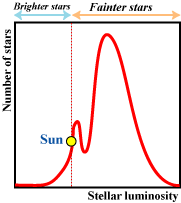 The
Sun is no average star. It outshines mostother stars in the Galaxy.
The
Sun is no average star. It outshines mostother stars in the Galaxy.
Deep within the Sun's core, nuclear reactions convert 600 M tons
of hydrogen into helium each second.
- >Top Planets' mean distance and mean
temperature:
- A planet's distance strongly affects its temperature. But if
a planet's atmosphere contains greenhouse gases, the planet traps
warmth from its star. The explains why Venus is hotter than Mercury.
- If it weren't for the greenhouse effect, Earth would be an ice-covered
world that might never have spawned life.
2. 現在の太陽系:
- <左図> 恒星の光度:
太陽は平均的な星ではない。我々の銀河系の他の多くの星より明るく輝いている。
- 太陽の中心部では、核反応によって毎秒6億トンもの水素がヘリウムに転換している。
- <左図> 惑星の平均距離と平均温度:
惑星の距離はその温度に強烈に影響する。しかもし惑星の大気が温室効果ガスを含んでいれば、惑星はその星からの熱を保持する。これによって金星が水星より温度が高いことが説明できる。もし温室効果がなければ地球は氷に覆われた世界となり生命の誕生はなかったかもしれない。
>Top Planetary paths: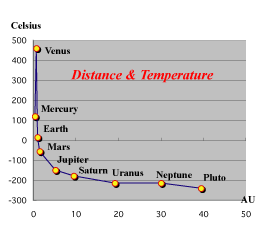
-
Remarks: AU = astronomical unit (150M km); ly
= light-year (9.46T km)
- A less massive star than the Sun has less gravity, so its planets
move sluggishly and take longer to revolve. The opposite holds
true for a more massive star, whose planets would revolve faster.
- The motions of the solar system's planets
exhibit two features: all revolve around the Sun in the same direction
as the Sun spins, counterclockwise from north pole, and their
orbits lie close to a single plane.
- >Top Planetary spin axes are not exactly perpendicular
to their orbits. Earth's axis tilts 23.4 degrees, which causes
the season. Uranus' axis tilts 97.9 degrees, and Venus spins backward.
- (Cf: Bright nearby
double stars)
Most double stars have high orbital eccentricities,
so orbital eccentricity provides a good diagnostic to distinguish
stars from planets.
- Most planets have moons revolving around them.
Only seven moons are large, and Earth is blessed with one of them,
whose tides stir the seas and may have pushed life from the ocean
onto the land. Jupiter has four large moons (Io, Europa, Ganymede,
Callisto), Saturn one (Titan), and Neptune one (Triton).
惑星の軌道:
- 太陽より質量の小さな星は重力も小さいので、その惑星はもっと長い時間をかけて周回する。反対にもっと大きな質量の星の場合は、その惑星は早く周回する。
- 太陽系の惑星の動きには2つの特徴がある。それはすべての惑星が太陽のスピンと同じ方向に、北極から見て反時計回りに回転していることである。さらにその軌道はほとんど単一面上にあることである。
- 惑星のスピンの軸はその周回に垂直ではない。地軸は23.4度傾いていることで季節を生じる。天王星の軸は97.9度傾いており、金星に至っては反対向きにスピンしている。
- (参照:近くの二重星との比較) 多くの二重星の周回の離心率は大きい。この周回の離心率は星か惑星かを識別する良い検査になる。
- 多くの惑星にはその周りを周回する衛星がある。7つの衛星が多いが、地球の月もその一つであり、これによる潮の干満が生命を海から陸地へ進展させたのかも知れない。木星には4つの大きな衛星、イオ、エウロパ、ガニメデ、カリストがあり、土星にはタイタンが、海王星にはトリトンがある。
>Top Origin of
the planets:
- The planets originated in a disk of gas and dust that revolved
around the newborn Sun. The inner part of the disk was rapidly
rotating and thus hot, only rock and iron could condense. In the
cool outer reaches of the solar nebula, ice condensed and became
part of the planets. Because of this extra material, and because
of the large area of the outer disk, the plants grew large. Their
gravity grabbled gaseous material from the disk, mostly hydrogen
and helium. Pluto and the icy bodies now in the Kuiper belt escaped
collision with the eight main planets and thus survived.
惑星の起源:
- 惑星は新たな生まれた太陽の周りに回転するガスや塵の円盤から生まれた。この円盤の内側部分は速く回転したので温度が高く、岩石や鉄だけが凝固できた。冷たい太陽の雲の外側部分では、氷が濃集して惑星の一部となった。円盤の外側にある大量の物質と円盤の広い面積とが、そこの惑星を大きく成長させた。それらの重力によってさらに主に水素やヘリウムから成る円盤のガス物質の濃縮された。冥王星およびカイパーベルトにある氷の物体は8つの主な惑星との衝突を逃れて生き残ったものである。
>Top Planets' data:
Planet
Orbital period
Speed km/sec
Orbital eccent-ricity
Orbital inclina-tion
Distance from Sun
Length
of day
Axial tilt deg
Sunlight intensity
Mercury
88d
47.9
0.206
7.0
0.39AU
58.65d
2.0
6.67
Venus
225d
35.0
0.007
3.4
0.72AU
243.0d
177.3
1.91
Earth
365d
29.8
0.017
0.0
1.00AU
23h56m
23.4
1.00
Mars
687d
24.1
0.093
1.8
1.52AU
24h37m
25.2
0.43
Jupiter
11.9y
13.1
0.048
1.3
5.20AU
9h55m
3.1
0.037
Saturn
29.5y
9.6
0.054
2.5
9.54AU
10h39m
26.7
0.011
Uranus
84.0y
6.8
0.047
0.8
19.2AU
17h14m
97.9
0.0027
Neptune
165y
5.4
0.009
1.8
30.1AU
16h7m
29.6
0.0011
Pluto
248y
4.7
0.25
17.1
39.5AU
6.39d
122.5
0.00064
Alpha Centauri A & B
80y
0.52
4.35 ly
Sirius
A & B
50y
0.59
8.5 ly
Procyon A & B
40y
0.36
11.4 ly
>Top 3. The Sun's Distant Outposts:
- The Asteroid:
Titius-Bode law was first mentioned by Johan D.
Titus in 1766; Titius stressed the gap between mars and Jupiter,
where the law said a planet should lie.
- In 1801 Ceres discovered:
Not only did the gap between Mars and Jupiter harbor an apparent
planet, as the Titius-Bode law predicted, but its distance from
the Sun matched almost exactly that laid down by the law: 2.77 AU,
versus a prediction of 2.80 AU.
Ceres is the largest asteroid, but it is only a quarter the diameter
of the Moon.
- >Top In 1802 Pallas:
Olbers notice a "star" in that constellation which seemed
out of place. He discovered that like Ceres, it moved. This object,
which he named Pallas.
- In 1804 and 1807; Astronomers found Juno and Vesta.
- Today known asteroids number in the thousands.
- In 1781 Neptune discovered:
Gravity is invisible, but it was through gravity that astronomers
first saw Neptune. Neptune exerts a gravitational force on Uranus
that speeds it up or slow it down.
- Although the discovery of Neptune brought fame to Adams and
Leverrier, one of the biggest winners was Isaac Newton, whose
law of gravity had predicted the existence and place of an entirely
new world.
3. 太陽の辺境の植民地:
- 小惑星:
ティティウス・ボーデの法則:
1766年にヨハン・ティティウスが火星と木星の間の隙間を指摘し、ある惑星がそこにあるべきと予測した
- 注)各惑星の軌道半径が0.4+0.3x2n
(金星 n=0、地球 n=1、....)
- 1801年セレス発見:ティティウス・ボーデの法則の予想通り、火星と木星の間に明らかな惑星が見つかっただけでなく、その太陽からの距離も2.80
AUの予測に対し、2.77 AUという正確なものだった。
セレスは、最大の小惑星であるが、その直径は月の1/4に過ぎない。
- 1802年パラス発見:
オルバースはその星座の中に場違いな星に注目した。それはセレスと同様に動いたのである。彼はこの物体をパラスと名付けた。
- 1804および1807年:小惑星のユーノおよびベスタがそれぞれ発見される。
- 小惑星の数は今日では数千を数えている。
- 1781年海王星発見:
重力は見えないが、天文学者が最初に海王星を見つけたのは重力を通してである。海王星は天王星に対して重力によって天王星の速度を上下させる。
- 海王星の発見はアダムスとレヴェリエに名誉をもたらしたが、最大の勝利者はニュートンである。その重力の法則が全く新しい世界の存在と場所を予測したのである。
>Top The Phantom Planet:
- Whirling around the Sun in 88 days, Mercury occasionally passed
in front of the solar disk. Astronomers should have been able to
predict the times of these transits, but Mercury refused to cooperate.
It missed a transit in 1707 by a full day and another in 1753 by
several hours. Leverrier delved into the problem more deeply and
in 1859 blamed an unseen mass whose gravity pulled Mercury off course,
just as Neptune had Uranus. He called it Vulcan, after the god of fire and husband of Venus, and calculated that
it was only about a 1/3 of Mercury's distance from the Sun, and
mass at only 1/4 of the Moon's.
- Hoping to confirm Vulcan's existence in Mar 22, 1877, astronomers
scrutinized the Sun, but saw not a thing.
- The true solution came in 1915, when Albert Einstein formulated
his general theory of relativity.
幻の惑星:
- 太陽の周りを88日で周回する水星は時々太陽表面の前を横切る。天文学者はその通過の時刻を予測することができるが、水星は言うことを聞かない。1707年の通過の時は丸1日、1753年と時は数時間も予想とずれたのである。レヴェリエはこの問題を精査し、1859年に、あたかも海王星が天王星に及ぼしているようなまだ発見されていない物体が水星を軌道からずらせているせいであると断定した。彼はそれを火の神でありヴィーナスの夫にちなんでバルカンと命名し、太陽から水星までの距離の1/3にあり、その質量は月の1/4であると計算した。
- バルカンの存在を1877年3月22日に確認すべく、天文学者は太陽を精査したが、結局何も見つからなかった。
- この問題は、1915年にA.アインシュタインの一般相対性理論によって真に解決された。
>Top 4. Planet X:
- Great X-pectations:
During the 1980s and early 1990s, continuing problems
with both Uranus and Neptune convinced some astronomers that another
planet (Planet-X), beyond the orbits of both Neptune
and Pluto, might exist.
- Planet-X might also explain another anomaly in the outer solar
system. Every giant planet has a regular satellite system - except
Neptune, whose two best-known satellite have strange orbits. Yet
unlike any other big satellite, Triton circles its planet backward,
opposite from the direction of Neptune's spin. In 1949, a smaller
but equally odd moon (Nereid) revolves around Neptune
in the right direction, but its orbit is far more elliptical than
that of any other satellite in the solar system.
- In the late 1970s, Harrington explained; Triton, Nereid, and
Pluto were once normal moons of Neptune, going around Neptune
in the correct direction on nearly circular orbits. Then a large
Planet-X brushed by Neptune. The intruder's gravity reversed
the motion of Triton, giving it a backward orbit, elongated
the orbit of Nereid, giving it an extremely elliptical orbit,
sending Pluto on a highly elliptical orbit around the Sun.
4. 惑星X:
- 惑星Xへの期待:
1980年代から1990年代始めにかけて、天文学者は天王星と海王星の問題から、天王星、海王星、冥王星の軌道の外側にもう一つの惑星Xがあるものと考えていた。
- 惑星Xは外惑星系の異常を説明できるかもしれない。巨大惑星は規則的な衛星をもっているが、海王星には2つのよく知られた衛星は奇妙な軌道を回っている。他の大きな衛星と異なり、トリトンは海王星のスピンの向きと反対に回っている。1949年に発見された同様に奇妙な衛星ネレイドは、海王星の周りを通常の方向に回っているが、その軌道は太陽系の他の衛星より遙かに長楕円形である。
- 1970年代にハリントンの説明では、トリトン、ネレイド、冥王星はかつては海王星の通常の衛星で、海王星の周りを通常の向きでほぼ円軌道を回っていた。そこへ大きな惑星Xが海王星によってはじきとばされた。侵入した惑星Xによってトリトンに逆向きの回転が与えられ、ネレイドの軌道は引き延ばされて極端な長楕円軌道になり、冥王星は太陽の周りの長楕円軌道に送られた。
>Top Galileo:
- Galileo had discovered the four big moons of Jupiter in 1610, and
that these moons had provided him with crucial evidence that, contrary
to the Church's belief, not all celestial objects circle the Earth.
Galileo wrote, "Beyond fixed star 'a', another followed in
the same straight line; this is 'b' (now known to be Neptune), which
was also observed on the preceding night, but they then seemed farther
apart from one another." Thus, more than two centuries before
the planet's actual discovery, Galileo had not only observed Neptune
but also detected its motion.
- Galileo's position for Neptune in late Jan. 1613 differs markedly
from the modern ephemeris. Kowal and Drake suggested that this
provided evidence for Planet-X.
- >Top 4 spacecrafts:
Pioneer-10, Pioneer-11, Voyager-1, and Voyager-2 are now beyond
Neptune's orbit, and none of the four feels the gravitational force
of a tenth planet.
ガリレオ:
- 1610年にガリレオは木星の4つの衛星を発見し、これらの衛星は、教会の信念に反して、すべての天体は地球を回っている訳ではないという決定的な証拠をみつけた。ガリレオは書いている「固定的な星aの背景にもう一つの星が直線上に従っている。この星b(後に海王星として知られることになるが)はその前夜にも観測されたが、その後は互いに離れてしまった。」このように海王星が実際に発見される2世紀も前に、ガリレオは海王星を観察しただけでなくその動きも追跡していた。
- 1613年1月末にガリレオを記載した海王星の位置は現代の天文暦でいうと大きくことなっている。KowalとDrakeはこれは、Planet-Xの証拠を示すものであるかも知れないとした。
- 4つの探査機:
Pioneer-10、Pioneer-11、Voyager-1およびVoyager-2は現在は海王星の軌道を越えているが、どの探査機も10番目惑星の重力を検知してはいない。
>Top 5. A Shaky Start:
- Since the 1940s, astronomers have reported planets circling nearby
stars. No such worlds were actually seen, but their stars seemed
to wobble as they traveled across our line of sight. A star normally
moves through space in a straight line, so the wobble suggested
that the star was being tugged by the gravity of a orbiting planet.
- >TopThe Sun's nearest neighbors:
Surprisingly, most stars that are bright are not nearby, and most
stars that are nearby are not bright. Of the stars within a 12 ly
(light-years) of the Sun, only 3 are real spectacles: Alpha Centauri,
Sirius, and Procyon, which are among the ten brightest stars in
the sky. 4 other nearby stars glow only dimly: Epsilon Meridian,
Epsilon Indi, 61 Cygnic, and Tau Ceti. All the rest are invisible
without optical aid.
- 61 Cygni is the first star whose distance astronomers ascertained,
is barely visible to the naked eye in the constellation Cygnus.
In 1838, Wilhelm Bessel succeeded to detect the star's parallax.
- Parallax arises as the Earth circles the Sun and caused the
apparent positions of stars to shift slightly.
5. まずは星のゆらぎから:
- 1940年代以降、天文学者は近くの星を回る惑星を報告してきた。これらの世界は実際に見えないが、その星は我々の視線と直角に動くと震動する。星は直線上に空間を移動するのが通常であるが、震動するということは、その星が周回する惑星の重力によって引っ張られていることを示している。
- 太陽の近くの星々:
驚くことに多くの明るい星は近くの星ではない。また近くの星は明るくはない。太陽から12光年以内の星は、ケンタウルス座α星、シリウス、プロキオンの3つの星が顕著であり、これらは夜空で10個の明るい星に属する。その他の4つの近くの星はほのかに輝いているにすぎない。エリダヌス座ε、インディアン座ε、はくちょう座61、くじら座τである。その他の星は望遠鏡でなければ見えない。
- はくちょう座61は、初めて距離の測定ができた星であり、裸眼ではほとんど見えない。1838年にW.ベッセルがその星の視差を使った測定に成功した。
- 視差は地球が太陽の公転することで生じる星のみかけの位置変化である。(年周視差)
>Top The stellar pyramid: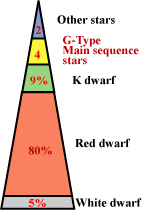
- Bright stars dominate the night sky, but in reality they make up
only a small percentage of the Galaxy's stars.
Most stars are red dwarfs, which are too dim for the naked eye to
see.
- Within 12 light-years of the Sun are 20 different star system
that contain 30 individual stars. Within 20 light-years, there lie
about 120 individual stars, within 40 light-years, about 1000 stars,
and within 100 light-years, about 15,000 stars.
星のピラミッド:
- 明るい星々は夜空に輝いているが、それらの星は実際は銀河系の中で小さな割合を占めるに過ぎない。ほとんどの星は赤色矮星であり、それは裸眼では見えない。
- 12光年以内には20の異なる星系があり、個別の星は30個ある。20光年以内には、個別の星は120個、40光年以内には1000個、100光年以内には15,000個の星がある。
>Top Main-Sequence Stars:
- A star's temperature affects its spectrum.
From hot and blue to cool and red, the seven main spectral types
are "Oh, Be A Fine Girl, Kiss Me."
- O-type stars are so rare than none appears
within many hundred of ly. The stars are few are born, and they
burn themselves out in just a few million years.
- B-type stars are also hot. The nearest is
Regulus, 74 ly. Many other B-type stars decorate the sky by
their intrinsic brilliance.
- A-type stars; one such star, Sirius, lies
within 12 ly, and lives for around a billion years - probably
not enough time for intelligent life to evolve.
- F-type stars: the first plausible life-supporting
stars. The nearest F-type star, Procyon, has already started
to evolve off the main sequence slightly.
- >Top G-type stars; breaks into G0, G1, G2, and
so on up to G9; the Sun is G2. This G-type star live for billion
of years. These stars make up only 4% of the stars in the Galaxy,
but the Milky Way is so huge that it harbors billions of such
stars. Alpha Centauri A, the brightest star in this triple system,
is G-type.
- K-type stars; sometimes called orange dwarfs
and are possible abodes of intelligent life, include such famous
stars as Alpha Centauri B, 61 Cygni, and Epsilon Eridani.
- M-type stars: By far the most common stars,
though, are the humble red dwarfs, range in mass from 8 to 60%
of the Sun's.
主系列星:
- スペクトル型による分類。表面温度が熱くて青い星から冷たくて赤い星まで7つに分類。
- O型:この星は非常に稀なので、数百光年以内には存在しない。この星は数が少ないだけでなく、数百万年で燃え尽きてしまう。
- B型:この星の温度も高い。最も近くにあるのはレグルスで74光年。その他多くのB型の星は強烈な明るさで夜空を飾っている。
- A型:12光年内にあるシリウスのような星で、10億年程度の寿命で、おそらく知的生命が進化するのは十分な時間とは言えない。
- F型:生命が存在しているかもしれない星。最も近いF型の星はプロキオンであるが、すべに主系列をすこし離れて進化しつつある。
- G型:G0, G1, G2からG9まで細分され、太陽はG2である。このG星の星は数十億年の寿命がある。これらの星は、銀河の中には4%しかないが、銀河は巨大なのでこのG型は何十億もある。ケンタルウスα星AもG型で、これは3重星である。
- K型:これは橙色矮星とも呼ばれ、知的生命を宿す可能性がある。有名な星はケンタウルスα星B、はくちょう座61、エリダヌス座ε星がある。
- M型:これは最も普通の星だが、暗い赤色矮星であり、太陽の質量の8%から60%しかない。
>Top Giant stars, etc.:
- Supergiant:
Stars with more than 8 times the mass of the Sun, that evolve into
a supergiant, such as Rigel and Betelgeuse. The
nearest is Antares, 500 ly away. Such a short-lived star, the supernova
explosion would fling the planets into space, where they would promptly
freeze.
- Giant:
Stars with less than 8 time the mass of the Sun, they evolve into giants, such as Arcturus and Aldebaran. They too
are poor prospects for life, for as they expand, they swallow some
of their inner planets and can boil way the oceans on others. A
giant gently casts off its outer atmosphere, forming a bubble of
glowing gas known as a planetary nebula (nothing to do
with planets)
- >Top Double/Tripple:
As Sirius and Procyon illustrate, many stars are double and some, like Alpha Centauri, triple. The Sun
is single, and single stars are the best candidate
for having planets. In a double or triple system, one star's gravity
can kick planets away from the other. Planet seekers prefer single
stars, or else very close double stars, so that the planets can
orbit both stars, or very far apart double stars, so that each star
can have its own planets with no interference from the other.
- Wobble:
If astrometry can reveal unseen stars, it might also revel unseen
planets as they too tug on their suns. Jupiter causes the Sun to
wobble by one 1.6 milliarcseconds. (a miliarcsecond
is 1/3,600,00 of a degree)
- The center of mass in the Sun-Jupiter system is a 1000 times
closer to the Sun than to Jupiter. Thus, the ideal planet is
a massive one far from its star.
巨星ほか:
- 超巨星:
太陽質量の8倍以上の星は、リゲルやベテルギウスのように超巨星に進化する。最も近くにあるのは500光年先にあるアンターレスである。これらは短い寿命のほしなので、超新星爆発によって惑星は宇宙空間に放り出されて、すぐに凍りついてしまうだろう。
- 巨星:
太陽質量の8倍以下の星は、アークツルスやアルデバランのような巨星に進化する。これらにも生命は宿らないだろう。というのはこれらの星は膨張して一部の内惑星を飲み込み、そうでなければ海を沸騰させてしまうことになる。巨星はその外側の大気を放り出して、惑星星雲と呼ばれるような輝くガスの泡を形成する。(この名は惑星とは関係ない)
- 二重星/三重星:
シリウスやプロキオンのように多くの星は二重星か、あるいはケンタルウスαのように三重星である。太陽は単一星であり、惑星を持つには最適である。二重星や三重星は、一方の星の重力で惑星が他方の星からはじき出されてしまう。惑星探査には単一星が望ましいか、あるいは二重星の場合は非常に接近していて惑星がそれらの星を周回するか、あるいは非常に離れた二重星であって、他方の星の影響なく各々の惑星を持てるからである。
- ゆらぎ:
天体測定学によって見えない星を発見できるのであれば、見えない惑星がその恒星を引っ張るので、その惑星を発見できるかもしれない。木星は太陽に対し1.6ミリ秒角の震動を生じさせる。(1ミリ秒角は1度角の3,600,000分の1)
- 太陽・木星系の質量の中心は太陽の側に1000倍も寄っている。従って惑星を発見するには星から離れた大きな惑星が適している。
>Top Spectral type:
Spectral type
Color
Mass
(Sun=1)
Visible light (Sun=1)
Lifetime
(years)
Giants, Supergiants
O
Blue
16-100
4K-15K
3-30 M
Alnitak A
B
Blue
2.5-16
50-4K
30-400M
Spica A,
Rigel
A
White
1.6-2.5
8-50
400M-2 B
Deneb
F
Yellow-
white
1.1-1.6
1.8-8
2-8 B
Canopus,
Polaris
G
Yellow
0.9-1.1
0.4-
1.8
8-16 B
Capella
K
Orange
0.6-0.9
0.02-0.4
16-80 B
Arcturus,
Aldebaran
M
Red
0.08-0.6
- 0.02
80 B-T
Betelgeuse,
Antares,
Mira
>Top6. The Vega Phenomenon:
- Vega: (αLyr)
Vega is indeed a special star, with 2.5 times more mass
than the Sun, spectral type of A0 and distance of 25 ly away. A
star with Vega's mass remains on the main sequence for only 400M
years. Astronomers have long used Vega as a standard reference,
comparing other stars with it to ascertain their apparent brightness.
(Visual magnitude = 0.0)
- >Top
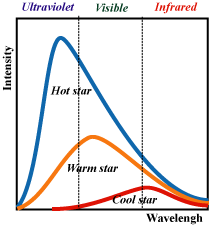 Stellar wavelength:
Stellar wavelength:
- A hot star is brighter at ultraviolet wavelengths, a warm star,
like the Sun, at visible wavelengths, and a cool star a infrared
wavelengths.
- The infrared part of the spectrum is the ideal place to investigate
cool objects throughout the universe.
- Vega's radiation
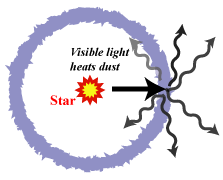
- This was coming from two different sources; the star proper and
something else, which was producing most of the infrared radiation
at wavelengths of 60 and 100 microns. "Something else "
was about -300F, similar to the temperature of Saturn.
6. ベガの現象:
- ベガ:(こと座α星)
ベガは特別な星である。太陽質量の2.5倍もあり、sペクトル型はA0で、距離は25光年である。ベガの質量の星は主系列に4億年しか留まれない。天文学者は長い間、他の星のみかけの明るさを比較する標準として利用してきた。(実視等級0.0)
- <左図>星の波長:
熱い星は紫外線波長の方が明るい、太陽のような暖かい星は可視光線の波長が、また冷たい星では赤外線波長の方が明るい。
- 宇宙全体の冷たい物体の探査には赤外線部分のスペクラムを利用するのが望ましい。
- <左図>ベガの放射:
これは2つの異なる熱源からやってくる。星自体ともう一つの物体が60-100μの赤外線放射をしている。もう一つの物体とは、温度が-180Cでほぼ土星の温度である。
>Top7. Dark Stars:
- Brown dwarf vs. Planet:
In short, a planet forms from the bottom up, whereas
a star forms from the top down.
- Mass:
There may be a mass gap between planets and brown dwarfs. If
the object is comparable in mass to Jupiter, it's planet; if
its mass is 10 Jupiters or more, it's a brown dwarf. In particular,
the region between 1 and 10 Jupiters - that is, between 0.1
and 1% of solar mass- is a blur.
- Composition:
A planet is nonsolar in composition. Jupiter is not a piece
of the Sun. The planet has an ice-rock core and so contains
a greater proportion of heavy elements than the Sun. Whereas
a brown dwarf, if it forms in a fashion similar to the formation
of stars, will be representative piece of comic stuff. It will
be like the Sun.
- >Top Orbit:
When we look at double stars, eccentric orbits are the common
denominator. The average double star has an orbital eccentricity
around 0.30, which means that the separation between the two
stars varies greatly. For example the distance between Alpha
Centauri A and B changes from 11 to 35 AU and back every 8 years.
In contract, the giant planets have nearly circular orbits.
Saturn has an orbital eccentricity of only 0.05, varies from
9 to 10 AU.
7. 暗黒の星:
- 褐色矮星と惑星:
端的に言えば、惑星はボトムアップで作られ、星はトップダウンで作られる。
- 質量:
惑星と褐色矮星の間には質量のギャップがある。もし対象物体が木星質量程度なら、それは惑星である。もしその質量が木星の10倍以上ならば、それは褐色矮星である。特に、質量が木星の1-10倍の範囲の場合、つまり太陽質量の0.1%から1%の場合はあいまいである。
- 組成:
惑星はその組成は太陽とは異なる。木星は太陽のかけらではない。惑星には氷や岩石の核があるので、重たい元素を太陽に比べてより多く含む
。一方褐色矮星の場合は星が形成されるのと同じように作られると仮定すれば、宇宙の代表的な物質から形成されることになり、それは太陽の組成に似てくる。
- 軌道:
二重星を見ると軌道の離心率に特徴がある。平均的な二重星は離心率が0.30程度であり、それは2つの星がかなり離れていることを意味する。例えば、ケンタルウスα星AとBとでは11から35AUも離れ、8年間で周回する。対照的に巨大惑星はほとんど円軌道を周回する。土星の離心率は0.05であり、9から10AUだけ変化する。
>Top Search for Brown Dwarfs:
- Absolute magnitude: how bright the stars would look from the
distance of 32.5 ly (10 parsec). Sun is +4.83
- Red stars that are far less luminous than the Sun might be
brown dwarfs.
- Proxima Centauri: absolute magnitude +15.52, a red dwarf,
10% of solar mass
- Wolf 359: +16.56
- VB 10: +18.67
- Unfortunately, neither redness nor dimness guarantees a star's
brown dwarf status.
- GD165: a very red star around a white dwarf in Bootes.
GD 165B could still be a red dwarf.
- HD114762 in Coma Berenices and the companion caused the
star to wobble along the line of sight. (Doppler shift),
companion revolves 84 days, with eccentricity at 0.38. Doppler
shift indicates 1% of solar mass, well below the threshold
of a main-sequence star.
褐色矮星の探査:
- 絶対光度:10パーセク(32.5光年)の距離から見えるの恒星の光度。太陽の絶対光度は+4.83
- 太陽より遙かに暗い赤色矮星は褐色矮星の可能性がある。
- ケンタルス座プロキシマ星 :
絶対光度 +15.52、太陽質量の 10%の赤色矮星
- Wolf 359: 絶対光度 +16.56
- VB 10: 絶対光度 +18.67
- 残念ながら赤色であることかつ暗いことだけで褐色矮星とは限らない。
- GD165:うしかい座の白色矮星の周りの非常に暗くて赤い星。まだ赤色矮星
- HD114762:かみのけ座にあり、伴星がこの星を視線に沿って揺らいでいる。伴星の周期は84日、離心率は0.38。度婦らー効果によって太陽質量の1%であり、これは主系列星の下限以下である。
>Top 8. Pulsar Planets:
- Discovery of Pulsar planets:
An average neutron star is 1.4 solar masses, but much
smaller in size, so its density if far greater: hundreds of trillions
of times that of water, or a billion times the density of a white
dwarf. One spoonful of neutron star matter weights a billion tons.
A pebble from a height of 4 ft, it would smash into the star's surface
at 5M miles per hour.
- In 1932, shortly after the discovery of the neutron, Lev Landau
speculated that neutrons could constitute a star's core.
- A pulsar is a rapidly rotating neutron star. It emits radiation
i a beam like a lighthouse.
- >Top PSR(Pulsating Source
of Radio):
In 1985 Andrew Lyne published the 'first' pulsar planet at PSR B1829-10
, some 35,000 ly from Earth.
- In 1991 the pulsar's pulse period was varying periodically due
to an orbiting body. A planet model matched the date perfectly.
It seemed to be the first extrasolar planet ever found: a world
with the mass of Uranus but on an orbit like that of Venus, circling
the pulsar every 6 months.
- But in 1992, Lyne reexamined the pulsar and concluded that there
was no planet around that pulsar.
8. パルサーの惑星:
- パルサーの惑星発見:
平均的な中性子星は太陽質量の1.4倍もあるが、サイズは遙かに小さく、その密度は数百兆倍もあり、白色矮星の数十億倍もある。スプーン一杯の中性子星物質は数十億トンにもなる。1.2mの高さから小石を落とすと、この星の表面に8百万km/hで激突する。
- 1932年に、中性子の発見の直後、L.ランダウは中性子が星の核を構成すると推測した。
- パルサーは高速で回転する中性子星であり、それは灯台のように放射線を放射する。
- PSR (パルサー的電波源)
1985年にA.Lyneが、35,000光年の所のパルサーPSR B1829-10で「最初の」パルサー惑星を発表した。注)PSR
B1829とは赤軽18時29分の意
- 1991年に、そのパルサーの波動周期は周回物体によって規則的に変化していた。惑星モデルを当てはめると完全に一致した。それは最初の地球外惑星の発見と思われた。その質量は天王星程度で金星のような軌道を6ヶ月で周回している、と。
- 1992年にLyneはパルサーを再調査の結果、パルサーを周回する惑星の存在を否定した。
>Top Pulsar Planets:
- In 1991, Wolszczan discovered that PSR B1257+12 in Virgo, 1300 ly away; spun once every 6.2 milliseconds. It was
single, so its companion had been completely destroyed, suggesting
the planets might be second-generation planets formed from blobs
of gas left over from the companion's death. The two planets were
in a 3:2 resonance: the inner planet completed 3 orbits in about
the same time that the outer planet made 2. A similar 3:2 resonance
holds in our own solar system, between Neptune and Pluto.
- Wolszczan also discover another planet inside of the other
two; circled the pulsar every 25 days. Its mass was little greater
than the Moon's.
- If the orbital distances of the three pulsar planets were
doubled, they would nearly line up with the positions of Mercury,
Venus and Earth.
- If the pulsar beam doesn't hit the planets, then there's really
no substantial radiation of any kind that reached them, and
people who live there may be completely unaware that they are
circling something. If the pulsar's beam does strike the planets,
it would be like living inside Chernobyl; the spectrum of energy
is mostly gamma rays, high-energy electrons, positrons, ions.
- >Top One hypothesis:
an old neutron star is revived when a companion star dumps
material onto it. This caused the neutron star to spin faster
and faster, until it switched on again and becomes a millisecond
pulsar. The pulsar is destroying its companion star, and
in so doing a disk of material is created.
- Another hypothesis:
Two white dwarfs orbiting close to each other spiral together
and merge. If their total mass is great enough - over 1.4
solar massed - they might create a rapidly spinning neutron
star, a millisecond pulsar. In the process, a disk of leftover
material might appear around the newborn pulsar and give
birth to planets.
- Wolszczan says, "The only thing that is odd and unusual
is that the central object is a pulsar. If we replace the
pulsar with a normal star, people would be hopping around
like mad saying there must be life there and water and blue
lakes and waterfalls and whatever."
パルサー惑星:
- 1991年にWolszczanはおとめ座にある1300光年先のパルサーPSR B1257+12 (6.2ミリ秒で回転)を発見した。それは単一星であり、その伴星は完全に破壊され、その伴星の死に伴い残されたガスの塊から二次的に惑星が形成された可能性を推測した。2つの惑星は3:2の共鳴があり、内側の惑星が3周回する間に外側の惑星は2周回した。これは太陽系では海王星と冥王星とが同じく3:2の共鳴をしている。
- Wolszczanはまたこれら2つの惑星の内側にもう1つの惑星を発見し、その周期は25日で、その質量は月より少し大きいとした。
- もし3つのパルサーの惑星の距離を2倍に広げると、その位置関係は水星、金星、地球とほぼ同じになる。
- もしパルサーのビームがその惑星に届かないとすればそこへは何の放射もないので、そこにいる住民にとってはどこかを中心に周回していることは知り得ない。もしパルサーのビームが惑星にぶつかるとしたら、そこはチェルノブイリの内側のようになる。エネルギーの波長はほとんどがガンマ線、高エネルギー電子、陽電子、イオンである。
- 1つの仮説:
伴星が物質を流し込むことで、古い中性子星が再生し、これによっ中性子星のスピンがますます速くなり、ミリ秒回転のパルサーになる。このパルサーが伴星を破壊することで円盤状の物質が形成された。
- もう1つの仮説:
2つの白色矮星が互いに接近して回転し、合体する。もし合計の質量が十分であれば(太陽質量の1.4倍以上)となると、ミリ秒で高速回転する中性子星が形成される。この過程で円盤状の物質が新たな中性子星の周りに集まり、惑星を誕生させる。
- Wolszczan曰く、「唯一の異常なことは中心の物体がパルサーであるということだけだ。もしこのパルサーを普通の星に置き換えたら、人々は狂ったように喜ぶに違いない。そこには生命、水、青い湖、滝などがあるに違いないと。」
>Top 9. Thanks, Jupiter:
- Guardians of Life:
Wetherill originated this idea in 1992, that Jupiter and Saturn
are vital to intelligent life. Both planets are lifeless gas giants,
seemed irrelevant to the inhabitants of a small, wet world. His
idea followed from theories of how the solar system formed.
- When the planets were developing, 4.6 billion years ago, countless
comets roamed the solar system. Many of these collided with
one another to form the cores of the four giant plants, but
the mighty gravitational force of Jupiter and Saturn tossed
trillion of other comets away. As a consequence, few comes remain
to hit the solar system's planets today, sparing Earth in particular
form the devastating impacts that could have thwarted the development
of intelligent life.
- If this idea is correct, it raises the stakes in the search
for extrasolar giant planets. If astronomers fail to find Jupiters
- the planets that are easiest to detect - those solar systems
may posses no life at all, even if they have warm, wet planets
like Earth. Conversely, if planets like Jupiter abound, they
will boost the hope that life exists elsewhere.
9. 木星に感謝:
- 生命の守護者:
Wetherillは1992年に木星と土星が知的生命にとって必須であるという独自の主張をした。2つの惑星は生命ののいないガスの巨大惑星であり、小さな水の世界の住人にとっては関係がないように見える。彼の考えは太陽系がいかに形成されたのかという理論から来ている。
- 惑星が46億年前に形成されるときに、数知れぬ彗星が太陽系をさまよい、その多くは互いに衝突して、4つの巨大惑星の核を形成した。木星と土星の巨大な重力が、その他の何兆という彗星をはじき飛ばしたのだ。その結果、限られた数だけが太陽系の惑星に衝突し、特に地球は知的生命の進化が挫折するような致命的な衝突を防ぐことができた
- もし、この考えが正しければ、太陽系外の巨大惑星を探す意味が出てくる。もし木星のような巨大惑星は発見しやすいのだが、それを見つけられないとなると、その太陽系に地球のような暖かくて水のある惑星があったとしても、生命がいない可能性がある。逆にもし木星のような惑星があれば、生命が存在する可能性が広がる。
- >Top Doppler shift:
 A
star with a close-in planet orbits around the center of mass fast,
because the planet's period is short. This gives Doppler observers
the chance to detect the wobble. But because the wobble is small,
astrometrists, who measure the wobble's size, are out of luck.
A
star with a close-in planet orbits around the center of mass fast,
because the planet's period is short. This gives Doppler observers
the chance to detect the wobble. But because the wobble is small,
astrometrists, who measure the wobble's size, are out of luck.
- >Top Radial Velocity:
 The
Doppler shift that an observer detects in a star-planet system depends
on the orientation of the system. If an observer (1) views the system
edge-on, the star will move forward and away from the observer with
full force; and an observer (3) who views the star exactly pole-on
will see nothing, since the star does not move toward or away from
the observer as it wobbles. For this reason, Doppler observers cannot
normally determine a planet's mass.
The
Doppler shift that an observer detects in a star-planet system depends
on the orientation of the system. If an observer (1) views the system
edge-on, the star will move forward and away from the observer with
full force; and an observer (3) who views the star exactly pole-on
will see nothing, since the star does not move toward or away from
the observer as it wobbles. For this reason, Doppler observers cannot
normally determine a planet's mass.
- Advantage of the Doppler shift:
A star need not be near the Sun in order to show the effect.
In contrast, the technique works best on the closest stars.
- Disadvantage of the Doppler shift:
Inability to extract the exact mass of the orbiting body. Instead,
all the technique can establish is the object's minimum mass.
- In 1995, the Swiss team announced a genuine planet was circling
a yellow star in Pegasus. It was the first planet ever detected around a Sunlike star outside the solar system. (51
Pegasi)
- ドップラー効果:
- 近距離の惑星を伴う星は質量の中心付近を速く周回する、それは惑星の周期が短いからである。これはドッップラー効果の観測者にとって、星の揺らぎを観察するよい機会を与える。しかしこの揺らぎが小さければ観測者にとっては不運である。
- <左図>視線速度:
観測者が星・惑星系におけるドップラー効果による偏移はその系をどちらの方向から観察するかで決まる。(1) もし観測者が系の端を見ているとすると、星は観測者から見て前後に動く。(3)
また観測者が系を真横から見ているとすると、星は震動するが前後に動かない。この理由によって、ドップラー効果を観測する人は惑星質量を決められない。
- ドップラー偏移の長所:
この効果を示すには、星は太陽の近くにある必要はない。対照的に、この技術は近くの星に最も効果的である。
- ドップラー偏移の欠点:
周回する物体の質量を正確に捉えられない。この技術で可能なのは物体の最小質量を決めることである。
- 1995年にスイスのチームはペガスス座の黄色い星を周回する惑星を発表した。これは太陽系外で太陽のような星を周回する惑星として初めて見つかったものである。(ペガスス座51星)
>Top 10. Harvest Planets:
- 51 Pegasi: the first extrasolar planet around a normal star.
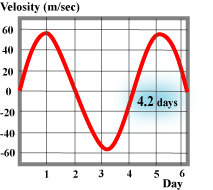 In
1995, the star's velocity varied periodically, once every 4 days.
It implied that the planet had about half of Jupiter's mass, but
the short period meant it circles the star in just 4 days.
In
1995, the star's velocity varied periodically, once every 4 days.
It implied that the planet had about half of Jupiter's mass, but
the short period meant it circles the star in just 4 days.
-
Queloz said, " This could be a very big discovery,
and we have to be very careful not to make a mistake. To report
a false planet would have been bad enough, but to report one so
unusual that its own bizarre nature called into question its very
existence would have been an even great embarrassment."
-
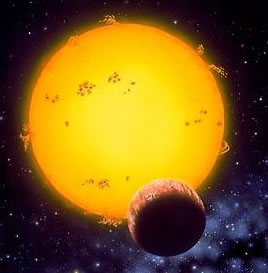 The
new planet revolved on a circular orbit every 4.2 days. It lay
a mere 0.05 AU from its star - only 1/8 the distance
between the Sun and Mercury - so 51 Pegasi must roast the planet
to a temperature of some 1300 degrees K, far hotter than any planet
in our solar system. Yet it had a mass roughly half that of Jupiter
and was presumably a gas giant.
The
new planet revolved on a circular orbit every 4.2 days. It lay
a mere 0.05 AU from its star - only 1/8 the distance
between the Sun and Mercury - so 51 Pegasi must roast the planet
to a temperature of some 1300 degrees K, far hotter than any planet
in our solar system. Yet it had a mass roughly half that of Jupiter
and was presumably a gas giant.
-
Viewed from the planet, the star would loom
some 20 times larger than the Sun looks in Earth's sky, and
the star's gravity would raise tides thousand of times stronger
than the Moon does on the Earth. These tides would force the
same side of the planet to face the star forever
-
To construct the large core requires a lot of
material - not just rock and iron, which exist throughout the
disk, but also ice, which is several times more abundant but exits
only far from the star, where the disk is cool. Extrasolar Jupiters
would exist a distance of around 5 AU from their stars, just as
Jupiter does.
-
One possibility:
The disk of orbiting material must have been outrageously
massive to create a rock-iron core great enough to grab large
amounts of hydrogen and helium and become a gas giant.
-
Another possibility:
It is that the world is an overgrown terrestrial planet, a
giant hunk of pure rock and iron, because then the disk must
have been even more massive in order to form a rock-iron object
that big.
-
Third possibility:
The planet formed farther out at around 5 AU, and then spiraled
closer into the star. The planet's migration from 5 AU to
0.05 AU must have disrupted the inner part of the solar system,
and would have kicked Earthlike planets out of the system
altogether. These may now be roaming interstellar space, cold,
dark , and lifeless.
-
The Sun's disk must have been thin enough
or short-lived enough that these planets remained far
from the Sun and never disturbed the inner planets.
Thus a planet like Jupiter may be a two-edged sword,
on the one hand protecting small plants from the impacts
of comets but on the other hand holding the potential
to eject those same planets out into the void
- The First Planets:
-
In 1996, Marcy and Butler reported planets around
the solar type stars Rho Cancri A, Tau
Bootis A, and Upsilon Andromedae. The
first two stars have red dwarf companions a large distance away,
showing that at least wide double star systems can have planets.
-
All three resemble the strange worlds around 51
Pegasi. The discoveries proved that 51 Pegasi was not unique;
giant planets located right next to their stars.
-
In 1997, the find featured Rho Coronae
Borealis, a Sunlike star 57 ly distant, around which
a Jupiter-sized planet was discovered, revolving every 40 days.
-
Bruno's Dream:
The discovery of planets around Sunlike stars greatly excited
the public. We are just on the border of discovering life.
10. 惑星の収穫:
- ペガスス座51星:
普通の星を回る初の太陽系外惑星
1995年は、星の速度が4日毎に定期的に変化した。これはその周りに木星質量のい半分の惑星が存在していることを示唆したが、その短い周期はなんと4日でその星を公転していることを意味した。
- Queloz曰く「これは非常に大きな発見かもしれないので、間違いを犯さないようにしなければならない。間違った惑星を報告するはまずいことには違いないが、非常のことを報告すると、そのあまりにも奇妙な性質が存在することでさらに大きな困惑をもたらすことになろう。」
- その新たな惑星は4.2日の円軌道で公転しており、星からの距離はなんと0.05AU、太陽と水星の距離の1/8に過ぎない。ペガスス座51星はおそらくその惑星を熱で焦がし、温度は太陽系のどの惑星よりも熱い1300度Kに達している。その質量は木星の半分ほどでおそらくガス状巨惑星であろう。
- その惑星からその星を見ると、地球から見える太陽の20倍も大きく見え、その重力は月が地球に及ぼす潮汐力の千倍にも及ぶ。これらの潮汐力によってその惑星は星に対し永久に同じ面を向けることになろう。
- 大きな核を作るには、円盤のすべてにおいて存在する岩や鉄だけでなく多くの物質が必要になる。 氷はその何倍も多く存在するが、星から離れた円盤の冷たい場所にしかない。太陽系外の木星達は、星から5AU程度離れた所に存在しているだろう。
- 可能性1:
周回している円盤の物質は非常に多いので岩・鉄の核を中心の水素やヘリウムをの濃集したガス惑星を作った。
- 可能性2:
巨大に成長した地球状惑星の場合で、岩と鉄から成る巨大な塊である。それは岩と鉄の物体がそれほどまでに大きくなるほど円盤の物質が豊富だったことによる。
- 可能性3:
その惑星は5AUほどの遠方で形成され、その後、星の方に近づいて行った。惑星が5AUから0.05AUにまで接近することによって内惑星を蹴散らし、地球状惑星をその系から蹴飛ばしてしまっただろう。これらの惑星は現在は恒星間の空間の冷たい暗黒の、生命のない状態でさまよっているかも知れない。
- 太陽の円盤は、適切な濃度であり、かつ短期間しか存在しなかったおかげで、これらの巨大惑星が太陽から遠方に留まることができた。このように木星のような惑星は両刃の剣である。一方では小さな惑星を彗星の衝突から防ぎながら、他方ではこれらを闇に向かって放逐する可能性を秘めているからである。
- <左図>最初の惑星:
- 1996年にMarcyとButlerは太陽状の星を回る惑星を発表した。カニ座ρ星A、うしかい座τ星A、アンドロメダ座γ星である。最初の2つは赤色矮星の伴星を遠方にもっているが、離れた二重星にも惑星があることを示した。
- 3つのケースについては、ペガスス座51星を回る奇妙な世界と似ている。それはペガスス座51星のように巨大惑星が星のすぐ傍を回っているということが特別でないことを証明した。
- 1997年に57光年離れた太陽状の星であるかんむり座ρ星を40日周期で公転する木星状の惑星が発見された。
- G.ブルーノの夢:
太陽のような星を回る惑星の発見は感激をもって広く伝えられた。我々はまさに生命を発見する入口に立ったのである。
>Top
Exoplanets:
Name
Year
Distance (AU)
Period (d, y)
Mass
Earth=1
Mass
Jup=1
Eccent-ricity
Temp. Celsius
Mercury
0.39
88 d
0.055
0.206
120
Venus
0.72
225 d
0.815
0.007
460
Earth
1.00
365 d
1.000
0.017
16
Mars
1.52
687 d
0.107
0.093
-55
Jupiter
5.20
11.9 y
317.8
1.00
0.048
-149
Saturn
9.55
29.5 y
95.16
0.30
0.056
-178
Uranus
1781
19.22
84.0 y
14.54
0.045
0.046
-214
Neptune
1846
30.11
164.8y
17.15
0.054
0.009
-214
Pluto
1930
39.54
247.8y
0.0023
0.249
-240
PSR
B1257+12a
1993
0.19
25 d
0.019
0.0
?
PSR
B1257+12b
1991
0.36
67 d
4.3
0.018
?
PSR
B1257+12c
1991
0.47
98 d
3.6
0.026
?
51 Pegasi b
1995
0.05
4.2 d
0.6
0.0
1000
Rho Cancri A b
1996
0.11
14.6 d
1.0
0.0
700
Tau Bootis A b
1996
0.05
3.3 d
4.9
0.0
1200
Upsilon Andromedae b
1996
0.06
4.6 d
0.8
0.0
1100
Rho Coronae Borealis b
1997
0.23
39.6 d
1.5
0.0
300
47 Ursae Majoris b
1995
2.1
3.0 y
3.0
0.03
-70
>Top 11. Future Worlds:
- Traditional Astrometrics:
Plant searchers hunted for their prey astrometrically, through planet-induced
wobbles in a star's motion across our line of sight; but
for decades astrometry produced only false detections.
- Doppler technique:
It looks for wobbles in a star's motion along our line
of sight. This is essential how the first pulsar planets were discovered
in 1991. The 1995 discovery of the planet of 51 Pegasi also resulted
from this technique, as did most of the other plants reported in
the mid-1990s.
- Keck telescope in Hawaii, the largest optical telescope: attains
a Doppler precision of 2 m per second, sufficient
to reveal a Jupiter around a Sunlike star.
- Multichannel Astrometric Photometer (MAP) at Allegheny Observatory; have a precision of 1 milliarcsecond,
sufficient to detect a Jupiter around a Sunlike star 10 ly away.
- Optical Interferometer:
It combines the light received by two or more separate telescopes
to yield sharp views. In 1991 Dale Frail used the Very Large Array
(VLA) in New Mexico to measure the first pulsar with planets, PSR
B1257+12.
- Infrared Interferometer: atop Palomar Mountain;
It measured in microarcseconds. A Jupiterlike planet orbiting a
Sunlike star 10 ly away would induce an astrometric wobble of 1600
microarcseconds, and Earth 1 microarcsecond. The Palomar interferometer
has a precision of 50 microarcseconds.
- Adaptive Optics: new ways to detect planets directly.
This idea was first proposed in 1953 by Horace Babcock. It is a
technique that untwinkles the stars, showing images as sharp as
those from a telescope in space. For years this information was
classified, but in 1991 the military released it to astronomers.
Adaptive optics undoes the damage a light wave suffers as it navigates
through the atmosphere. To know the exact damage done, the system
observes a bright reference star. Then, to correct this damage,
a "rubber" mirror bends and flexes in such a way that
it continually undistorts the light and give a sharp view of the
bright object and any objects near it.
11. 未来の世界:
- 伝統的な位置天文学:
惑星探しは、我々の衛星によって星の揺らぎが視線と直交する動きという位置天文学的な方法で対象を追求した。しかし何十年もこのやり方では結果が出なかった。
- ドップラー技術:
これは視線に沿った星の動きによる震動を見ている。これによって1991年に最初のパルサーの衛星が発見された。1995年のペガスス座51星の惑星の発見もこの技術によるもので、1990年代中旬の多くの惑星の発見に同様である。
- 世界最大の光学望遠鏡のあるハワイのKeck望遠鏡によるドップラーの精度は2m/秒であり、太陽状星を回る木星を発見するには十分である。
- 多チャンネル天文測定光度計(MAP)
:
Allegheny観測所にあるMAPは、1ミリ秒角の精度があり、10光年先の太陽状の星を回る木星状惑星を発見するには十分である。
- 光学干渉計:
これは鮮明な像を得るために2カ所以上の離れた望遠鏡による光を合成する。1991年にDale FrailはニューメキシコにあるVLAが、最初の惑星をもつパルサーPSR
B1257+12を測定した。
- 赤外線干渉計:
パロマー山頂にあり、マイクロ秒角まで観測できる。10光年離れた太陽状の星を回る木星状惑星は1600マイクロ秒角の揺らぎを生じ、地球上惑星の場合はこれが1マイクロ秒角となる。パロマー山の干渉計の精度は50マイクロ秒角である。
- 適応光学 (波面補償光学, Adaptive
Optics):
( 柔軟な鏡や膜を用いて,像のゆがみを補正する光学部門)
このアイデアは1953年にHorace Babcockによって提唱された。これは星のまたたきを除去し、宇宙空間にある望遠鏡のように鮮明な画像を得る技術である。この情報は何年も機密扱いであったが、1991年に軍は天文学者に開放した。
適応光学は大気中を通ってきた光波の損失を補う。損失の程度を正確に知るために、このシステムは明るい星を標準として観測する。それからこの損失を訂正するために"ゴム状"の鏡を曲げたり伸縮させたりして光りのゆがみを訂正し明るい物体およびその近くの物体の鮮明な画像を得る。
>Top Hubble Space Telescope (HST):
- cost $0.5B, will achieve an accuracy of about 1 microarcsecond,
almost enough to sense the wobble induced by an Earthlike planet
10 ly away.
A space-borne infrared interferometer would see the planets both
by attain extremely sharp views and by canceling out the light waves
of the central star. The interferometer can cancel a star's light
by adding the crests of this light waves received by one telescope
to the troughs received by the other one. Off-center objects, like
a planet, will generally not be canceled. (called nulling interferometer)
- A similar trick can eliminate vocals from CD. Since vocals are
usually equal left and right, they get eliminated, whereas musical
instruments are biased to either the left or right and remain.
The vocals are like stars, and the musical instruments like planets.
- Key molecules:
The infrared section of the spectrum offers the best chance to see
not only Earthlike planets but also extraterrestrial life.
Carbon dioxide is
common in the atmosphere of Venus, Earth, and Mars, and it tells
that the planet have an atmosphere; water
vapor tells that it has oceans, and ozone tells life. Most oxygen is much harder to detect on another planet
than ozone.
- >Top Atmosphere of Venus, earth, and
Mars:
(Abundance by volume in %)
-
Gas
Venus
Earth
Mars
CO2
96.5
0.035
95.32
N2
3.5
78.08
2.7
O2
-
20.95
0.13
H2O
0.003
0 to 4
0.03
He
0.001
0.0005
-
H2
-
0.00005
-
O3
-
0.00004
0.00001
-
ハッブル宇宙望遠鏡(HST):
- 費用5億ドル。精度1マイクロ秒角で10光年先の地球状惑星による揺らぎを観測可能。
宇宙に浮かぶ赤外線干渉計は、非常に鮮明な画像と中心星の光のキャンセル技術によって惑星を見ることができる。干渉計は星の光を1つの望遠鏡から得られる光波の山ともう1つの望遠鏡から得られる光波の谷を加算することでキャンセルする。惑星のように視野の中心にない物体はキャンセルされない。
- 同じやり方でCDの声楽を除去できる。声楽は通常は左右同じなので除去できる。一方、楽器の場合は左右に偏っているので残るのである。ここで声楽は星で、楽器が惑星に相当する。
- 重要な分子:
赤外線のペクトラムの一部には地球状の惑星のみならず地球外生命探査にとっても重要なチャンスがある。
二酸化炭素は金星、地球、火星の大気にはありふれており、その惑星には大気があることを示している。水蒸気の存在は海があることを示しているし、オゾンの存在は生命がいることを語っている。他の惑星の酸素を同定することはオゾンよりも遙かに難しい。
- <左表>金星、地球、火星の大気 (体積比)
>Top 12. Into The Cosmos:
- Cosmic Symphony:
During 1990s, astronomers established that the universe
at large possess the four basic astronomical ingredients for life.
- Stars forge life-giving elements like carbon
and oxygen; giant galaxies sculpt these life-giving
elements and recycle them into new star systems.
- Planets can provide stable platforms on which
life might arise, develop, and thrive. At least 3 Earthlike
planets exist around a pulsar in Virgo, and Jupiterlike plants
circle sunlike stars in Pegasus, Bootes, Ursa Major, and elsewhere.
Someday astronomers will also be able to discover extrasolar
Earthmass planets around Sunlike stars and determine which have
water and life.
- Life could not exist if the universe did not have the specific
properties that it does: If the gravitational force
were weaker..., if the primordial universe had possessed equal
quantities of matter and anti matter...., if the carbon atom
did not have the specific resonance...
12. 宇宙の中へ:
- 宇宙のシンフォニー:
1990年代を通じて、天文学者は宇宙には生命にとって4つの基本要素があることを確立した。
- 星は、炭素や酸素のような生命の構成要素を作り出す。巨大な銀河がこれらの生命構成要素を彫りだし、新たな星の系にリサイクルする。
- 惑星は生命が誕生し、進化し、繁栄するための安定した基盤を提供する。すでにパルサーを回る地球状の惑星が3つ発見され、またペガスス座、うしかい座、おおくま座などには木星状の惑星が発見されている。いつの日か天文学者は太陽のような星を回る地球状惑星で、そこに水と生命があることを発見することができるだろう。
- この宇宙の物理特性が違っていたら生命は存在し得なかっただろう。もし重力がもっと弱い、もし原始宇宙が物質と反物質がおなじ量だったら、もし炭素原子が特定の共鳴現象を示さなかったら。
Comment
- This book gives us positive
message of searching the evidence of "we are not alone."
"The future will be exciting: For technical reasons, we had been
constrained to look at big bright things, like stars and galaxies.
But now we can look at planets, which have so much human
interest. Astronomers will continue to scrutinize the planets across
a gulf of trillions of miles. But vast though it is, that gulf is
one which scientists of 21C may just be able to bridge."
- この本は「我々は孤独ではない」という証拠探しについての前向きなメッセージが込められている。
『未来は刺激的である。今までは技術的な理由は我々はやむなく大きな輝きをもつ星や銀河に制限されていた。しかし今や我々は人類がもっと関心を寄せる他の惑星を見ることができるようになった。天文学者は何兆マイルも離れたそれらの惑星を精査を続けることだろう。その溝がいかに遠くとも21世紀の科学者はきっとそこに橋を架けてくれることだろう。』
 |
Planet Quest
|
Cat: SCIPub: 1997#: 0221b |
Ken Croswell |
02531u/18130r |
Title |
Planet Quest |
惑星探索 |
|---|---|---|
Sub Title |
The Epic Discovery of Alien Solar Systems |
他の太陽系発見の叙事詩 |
Author |
Ken Croswell |
ケン・クロスウェル |
Published |
1997 |
1997年 |
|
||
Just |
>Top Feb 17 1600:
|
1600年2月17日
|
English |
Japanese |
>Top 1. A Good Planet Is Hard To Find:
|
1. 良い惑星は見つけにくい:
|
>Top Four crucial actors:
|
4人の主役:
|
>Top 2. A Living Solar System:
|
2. 現在の太陽系:
|
|||||||||||||||||||||||||||||||||||||||||||||||||||||||||||||||||||||||||||||||||||||||||||||||||||||||||||||||||||||
>Top Planetary paths:
|
惑星の軌道:
|
|||||||||||||||||||||||||||||||||||||||||||||||||||||||||||||||||||||||||||||||||||||||||||||||||||||||||||||||||||||
>Top Origin of the planets:
|
惑星の起源:
|
|||||||||||||||||||||||||||||||||||||||||||||||||||||||||||||||||||||||||||||||||||||||||||||||||||||||||||||||||||||
>Top Planets' data:
|
||||||||||||||||||||||||||||||||||||||||||||||||||||||||||||||||||||||||||||||||||||||||||||||||||||||||||||||||||||||
>Top 3. The Sun's Distant Outposts:
|
3. 太陽の辺境の植民地:
|
>Top The Phantom Planet:
|
幻の惑星:
|
>Top 4. Planet X:
|
4. 惑星X:
|
>Top Galileo:
|
ガリレオ:
|
>Top 5. A Shaky Start:
|
5. まずは星のゆらぎから:
|
>Top The stellar pyramid:
|
星のピラミッド:
|
>Top Main-Sequence Stars:
|
主系列星:
|
||||||||||||||||||||||||||||||||||||||||||||||||
>Top Giant stars, etc.:
|
巨星ほか:
|
||||||||||||||||||||||||||||||||||||||||||||||||
>Top Spectral type:
|
|||||||||||||||||||||||||||||||||||||||||||||||||
>Top6. The Vega Phenomenon:
|
6. ベガの現象:
|
>Top7. Dark Stars:
|
7. 暗黒の星:
|
>Top Search for Brown Dwarfs:
|
褐色矮星の探査:
|
>Top 8. Pulsar Planets:
|
8. パルサーの惑星:
|
>Top Pulsar Planets:
|
パルサー惑星:
|
>Top 9. Thanks, Jupiter:
|
9. 木星に感謝:
|
|
|
>Top 10. Harvest Planets:
|
10. 惑星の収穫:
|
||||||||||||||||||||||||||||||||||||||||||||||||||||||||||||||||||||||||||||||||||||||||||||||||||||||||||||||||||||||||||||||||||||||||||||||||||||||||
>Top Exoplanets:
|
|||||||||||||||||||||||||||||||||||||||||||||||||||||||||||||||||||||||||||||||||||||||||||||||||||||||||||||||||||||||||||||||||||||||||||||||||||||||||
>Top 11. Future Worlds:
|
11. 未来の世界:
|
>Top Hubble Space Telescope (HST):
|
|
>Top 12. Into The Cosmos:
|
12. 宇宙の中へ:
|
Comment |
|
|
|---|